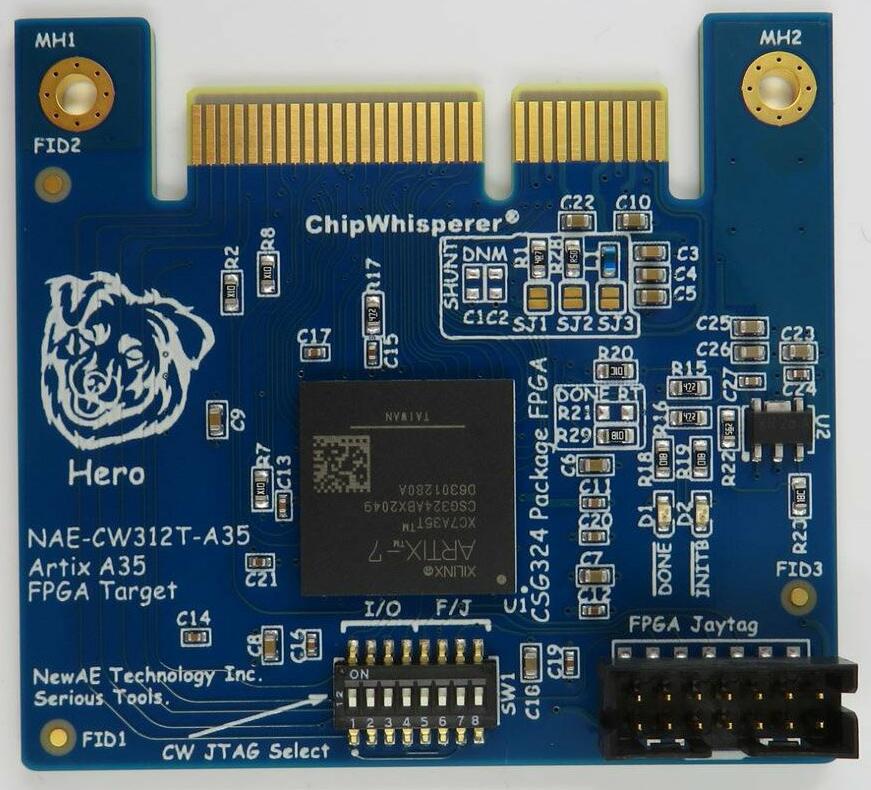CW312T-XC7A35¶
Xilinx Artix7 A35 Target for ChipWhisperer, with CW312 edge connector.

JTAG Options¶
The target board has a Xilinx JTAG header (labeled "FPGA Jaytag" on the PCB) which connects to the FPGA's JTAG port, for programming the FPGA via Xilinx tools, or for using FPGA ILAs.
Additionally, the "CW JTAG Select" DIP switch provides some additional JTAG routing options: 1. When switches 5-8 are "on", the JTAG header pins on the carrier CW313 board (TDI, TDO, TMS, TCK) are routed to the FPGA's JTAG port. 2. When switches 1-4 are "on", the JTAG header pins on the carrier CW313 board are routed to another set of FPGA pins (TDI, TDO, TMS, TCK to A11, C12, B11, B12 respectively), which allows connecting to e.g. a soft-core JTAG port. Refer to the schematic to see exactly how this is done.
Shunt Selection¶
Because it's hard to have an optimal one-size-fits-all shunt for FPGA targets, there are 3 shunts to choose from:
-
47 nH inductor
-
0.5 Ω
-
4.7 Ω
The active shunt is selected by a solder blob on SJ1, SJ2 or SJ3.
Example Target Cores¶
The A35 target can run our example AES, pipelined AES, and ECC cores.
Pre-built bitfiles for all of these targets are included in the ChipWhisperer repository, and can be explored via the notebooks (linked above). To learn how to build these bitfiles yourself, head over to the FPGA target area of the chipwhisperer repository here.
Example Soft Cores¶
1. Ibex¶
We also provide a bitfile for a pre-built RISC-V Ibex core.
To compile firmware for this target using our build infrastructure, set
TARGET to CW312_IBEX. This will pull in the
Ibex HAL.
Ensure you have a version of riscv32-unknown-elf-gcc recommended by the
lowRISC project.
Then, compile target firmware
here
as you would for any of our other targets.
Alternatively, you can also build target firmware from the
Ibex demo repository
following the Ibex methodology; there you will find our simpleserial-aes and
basic-passwdcheck firmware as examples.
After loading the FPGA bitfile (which can be done via the Setup_Ibex.ipynb script, if using our pre-built bitfile), you'll need to program your target firmware separately, using an external JTAG programmer connected to the A35's FPGA JTAG port, not the soft-core port (e.g. connect your programmer TDI/TDO/TCK/TMS to those header pins on the CW313 board, set DIP switches 5-8 to "on" on the A35 target board, and disconnect any other JTAG programmer from the A35's "jaytag" header).
To program the firmware onto the FPGA soft-core, refer to the instructions
here.
Those instructions run out-of-the-box on their default Arty FPGA platform;
you will likely need to modify their load_demo_system.sh script for your
own JTAG programmer.
Alternatively, you can avoid the firmware programming step by embedding your target firmware into your FPGA bitfile; however, this requires you to build the FPGA bitfile yourself (and re-building the bitfile every time you wish to modify the firmware).
The pre-built Ibex core's UART link operates at 115200 baud when clocked at 100 MHz and is suitable for use with SimpleSerial v1 (the Ibex design includes a PLL which expects a 100 MHz input clock; you can lower the clock frequency and scale the baudrate accordingly, but only to a certain point because the PLL will stop functioning correctly if the input clock frequency is too far from 100 MHz).
2. Arm DesignStart¶
Look to our Arm DesignStart repository for instructions on building and using a soft-core Arm Cortex target.
Programming¶
The FPGA can be programmed with a Xilinx platform cable (or equivalent) connected to the "Jaytag" port, as explained above.
It can also be programmed with a ChipWhisperer-Husky as follows:
import chipwhiserer as cw
scope = cw.scope()
from chipwhisperer.hardware.naeusb.programmer_targetfpga import CW312T_XC7A35T
fpga = CW312T_XC7A35T(scope)
fpga.program(<path-to-bitfile>, sck_speed=10e6)
When using our example target cores and notebooks, the notebooks automatically handle programming the correct bitfile for you (via Husky).
Schematic¶
The schematic is available here.